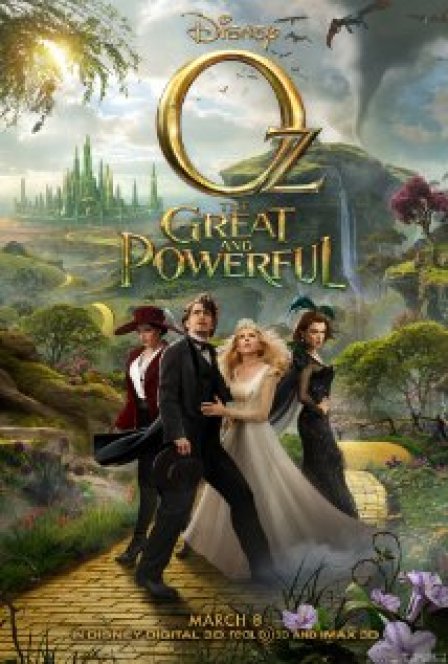The primary business model over at Disney — particularly when it comes to live action films — is apparently to repopulate the multiplexes with familiarity. Yes, there are blessed exceptions to this rule, but almost everything they’ve released over the past two years has been based on already existing material or was a sequel of some stripe. So, surprise surprise, the first big Disney effort of 2013 is the origin story of The Wizard of Oz (shown with previews for the next Iron Man and the Monsters, Inc. prequel, naturally).
Admittedly, the media giant is just playing to the marketplace. The general movie calendar for the foreseeable future is also chock-a-block with adaptations of books, TV shows, comics, and other movies, not to mention sequel after sequel after sequel. Trouble is, so many of these tend to be massive letdowns — not necessarily commercially, of course, but artistically and as simple exercises in storytelling. So, if you’re entering into the idea of seeing Oz The Great And Powerful with low expectations, we can’t blame you there. The funny thing is: those humble assumptions might just work to your own advantage and to that of Disney, because this is one of their rare variations on a familiar theme that actually works.
Chief in that success was the company’s choice of director. Like they did with 2010’s Alice In Wonderland, they handed the reins over to a known quantity, and one with a cultish following among film nerds. Unlike Tim Burton, Sam Raimi isn’t in the business of messing too heavily with good source material, Spider-Man 3 notwithstanding. The 53-year-old is a classic genre filmmaker with an obvious love for the history of the medium. Some of his best work has been formulaic, in the best possible sense of that word. And when you look back through his filmography, you’ll find that he’s littered each one with homages, references, and straight-up facsimiles of older works (the Three Stooges nods that run throughout Army of Darkness, or the much reviled Saturday Night Fever riff in the last of his web-slinging trilogy).
Raimi, then, knew what he had to deliver here: a rip-roaring crowd pleaser that makes obvious nods to the 1939 classic. He jumps at this right out of the gate, opening up the story of Oswald Diggs (James Franco), a talented but manipulative magician in a traveling circus, in black and white and in a boxy 4:3 aspect ratio. Then, after Diggs is whisked away to Oz (via a tornado, naturally), the screen slowly opens up to an engrossing 16:9, each inch filled with sumptuous Maxfield Parrish-like imagery.
Once firmly ensconced in Oz, Raimi and screenwriters David Lindsay-Abaire and Mitchell Kapner can begin the story proper. In it, Diggs is found by a young witch named Theodora (Mila Kunis) who informs him that he is the prophesied savior come to take his rightful place on the throne as king of Emerald City. Ever the con man, Diggs immediately starts working the angles and using his store of magic tricks in place of his absent wizardry skills. Sweetening this deal is a vault full of gold, but with a hitch: he has to rid Oz of the Wicked Witch before he can claim any of his riches. When Diggs finds his prey, it turns out to be Glinda the Good (Michelle Williams) who informs him that the real Wicked Witch is already in the Emerald City in the form of Evanora (Rachel Weisz) who earlier was playing herself off as the new king’s loyal servant.
If this were a rollercoaster, it would be at this point that the cars would start plunging down the first big hill. All the major characters are in place and you know where the story is going to end up, so now audiences can simply sit back and enjoy the hell out of the ride. And the thrills are a-plenty here, with moments of terror, joy, and jaw-dropping spectacle all peppered with reminders of the Oz you know and love: the yellow brick road, Munchkins, bubbles as transportation, the flying monkeys (a genuinely scary fang-bearing presence here), and the skin crawling visage and cackle of the Wicked Witch of the West.
The filmmakers aren’t the only ones who embrace the spirit of old film tropes. All of the main actors here do their best to emulate models from Hollywood’s Golden Age, and nearly all of them succeed. The biggest surprise is Franco, who somehow becomes the leading man that he’s always been trumped up to be. He leaves his character actor trick bag at the door, and pours himself into this role of a con man turned hero. Even at his most unctuous, Franco finds a way to make you root for him, which makes his triumph feel that much more earned. Williams, as well, radiates purity and light even in the film’s darkest moments, calling to mind a young Liz Taylor and Grace Kelly. Weisz and Kunis, on the other hand, do decent enough work, but are swallowed up by their own overacting, particularly as the latter goes through the biggest part of her character’s emotional and physical transformation.
To Kunis’s credit, she’s never anything less than committed to her role even if her still nascent film acting abilities let her down. Like everyone else involved in the film, she knows she is referencing something that is deeply embedded in the cinematic firmament. Together, Kunis, Raimi, and the entire cast and crew embrace the challenge of building upon a beloved filmic foundation. In doing so, they catapult past the rest of the remake-and-remodel school of Hollywood to create and immersive, whiz-bang piece of entertainment that’s one of the most surprisingly enjoyable American films yet to be released this year.

